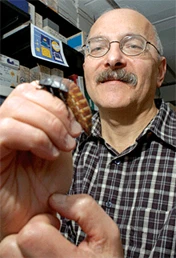
 Dr. Coby Schal Dr. Coby Schal |
Editor’s note: Welcome to Mallis Expert Insights. Each month, we will ask a Mallis Handbook contributor five pest control questions relating to his or her area of expertise. Connect with the experts by submitting questions and find their insights in upcoming issues. For the fourth installment of Mallis Expert Insights, PCT interviews North Carolina State University entomologist Dr. Coby Schal, author of the Cockroach chapter in the 10th edition of the Mallis Handbook of Pest Control.
Why is the cockroach such a popular subject of entomological research? What makes this pest so interesting to researchers?
Researchers often seek “model systems” that best address specific questions, but are also convenient to maintain in the lab. This is why the mouse and fruit fly are the work-horses of biomedical and genetics research, respectively. The cockroach has been a work-horse of insect physiology – the study of structure and function of whole organisms and of specific organ systems. Size matters since each insect organ is tiny! The larger cockroach species (Periplaneta americana and some of the blaberid species; see chapter if you don’t know what these are) have been indispensable for research in insecticide discovery, toxicology, endocrinology (this is where some of the juvenile hormone analogs came from), molting and cuticle formation, and many other areas. These big roaches also serve in biobot research because they are long-lived, hardy and can carry large payloads, and as inspiration for biologically-based robots. To evolutionary biologists, cockroaches represent a very old lineage from which we can learn a lot about the evolution of hemimetabolous development (look it up in the chapter!) and the emergence of sociality in cockroaches and termites.
Does the pest management industry do a good job of educating the public about the public health impact of cockroaches, particularly as it relates to cockroach allergens? Why or why not?
An emerging link between an environmental factor and human health, however tenuous, is rapidly picked up by the media, and covered in the news, self-help guides and doctors’ offices. By contrast, the medical importance of cockroaches is astonishingly poorly recognized by the public and the medical and regulatory communities. Cockroaches have been recognized for half a century as major triggers of respiratory disease, including allergies and asthma. We also have known for decades that they can transmit pathogenic microbes, including multi-drug resistant bacteria. Yet the public is largely unaware of this. The pest management industry has done an excellent job educating the public about the potential economic losses from termites, carpenter ants and wood-boring beetles. But we have not done as well communicating the potential health impacts of cockroach infestations. When it comes to indoor pests that can cause disease, such as cockroaches and bed bugs, I’d like to see greater emphasis on public education and more effort toward pest eradication.
What is the most important finding for PMPs from the recent cockroach glucose aversion research your laboratory at North Carolina State University conducted?
This research, in collaboration with Dr. Jules Silverman, is ground breaking because for the first time it uncovered the physiological basis for the rapid evolution of a new adaptive behavior in cockroaches in response to insecticide baits. We have known for decades that cockroach populations can rapidly develop resistance to insecticides through various genetic modifications in biochemical processes (mainly metabolic detoxification of the insecticide). But here, we found that a change in the sensory system (taste) can drive behavioral resistance to the bait. These findings inform us that roaches have a plethora of new, previously unknown mechanisms in their tool-box that they can recruit in their arms race with us. These findings will also guide the development of new baits that will bypass these adaptations in the cockroach. Bait manufacturers rapidly responded to glucose aversion by innovating and reformulating cockroach baits. There are two main things the PMP can do in the short-term: (1) conduct “taste tests” with cockroach infestations – offer them several baits and let the roaches guide which bait should be used, and (2) alert us when you encounter major control failures with properly deployed baits; we are very interested to discover how cockroaches innovate in response to our pest control advances.
What has Blanton Whitmire meant to you and the pest management industry?
Blanton has revolutionized the pest management industry in several ways. First, he so well understood the power of biology and behavioral observations as a gateway to innovations. He argued, as we all still do, that a central tenet of pest management is to properly target each pest based on its behavior – the “crack & crevice” treatment is an excellent example, and now an industry standard. Second, Blanton invested in a long-term collaborative relationship with Dr. Charles Wright at NC State, and this expedited both industry innovations and academic training and research. Third, Blanton valued the importance of PMP education and promoted the vision that the number one industry challenge is education. He developed and vehemently supported the Whitmire Scientific Symposium, and maintained that innovation, education, and efficacious products are the best investments in the company’s future. Fourth, Blanton’s philanthropy and generosity were evident as President and CEO of Whitmire Research Laboratories, but even more so in retirement – he and his wife Peg endowed four professorships at three universities, a major addition to the Missouri Botanical Gardens and they generously supported their St. Louis community. Blanton and Peg’s gifts to our Urban Entomology program at NC State University have enabled us to cultivate an integrated research and extension team, higher-risk research endeavors, and training of the next generation of urban entomologists. There is a short write-up about the Whitmires at http://www.cals.ncsu.edu/entomology/schal_lab/BlantonJWhitmireEndowment.
What do you see as future research needs of the industry as it relates to cockroaches?
There are so many unknowns! We are well on the way to sequencing the full genome of the German cockroach. This community resource will reveal genes, biochemical pathways, and neurogenetic networks that are unique to the cockroach and therefore potential target sites for novel and specific pesticides. It will likely reveal mutualistic associations with microbes that may be targets for disruption. I think baits will continue to dominate as the most efficacious formulation against cockroaches. Therefore, we will need to determine the frequency of glucose aversion in the U.S. and globally; investigate the relationship between glucose aversion and the evolution of metabolic resistance to insecticides; screen cockroach populations for aversion to other sugars and other nutrients; determine whether cockroaches learn and remember aversive stimuli (that is, glucose-containing baits) better or worse than rewarding stimuli; and finally, delineate the molecular genetic mechanisms of glucose aversion. Biological control of cockroaches has been relatively ineffective – why? Do cockroaches have a fantastically effective immune system? We discovered a highly species-specific virus that is pathogenic but very slow. Perhaps slight genetic modifications can make it more virulent as a pest control agent. We also need to investigate the impact of effective cockroach control on the allergens they leave behind and on associated health-related outcomes, especially in children. At the broader ecological level, international travel and commerce can lead to the emergence of new invasive pests. There are some cockroach species that associate with the built environment in Southeast Asia and Africa and we need to keep an eye on their global spread, as the Asian cockroach is marching west through Texas and into Mexico and north into North Carolina.
Where can pest management professionals learn more about your research?
A good place to start is our lab web site at http://www.cals.ncsu.edu/entomology/schal_lab/overview/. All our publications are available in PDF format at http://www.cals.ncsu.edu/entomology/schal_lab/Publications, and some of the media coverage of our work can be found at http://www.cals.ncsu.edu/entomology/schal_lab/Schal_labinnews. Happy surfing!
Latest from Pest Control Technology
- Veseris Announces Leadership Promotions
- Rentokil Terminix Innovation Center's Efforts in PMP Training, Pests Sustainability
- Michigan PMP Wins PCT’s Annual Photo Contest
- NPMA PRO Certified Applications Now Open for Pest Management Professionals
- Career Week at Truly Nolen Focuses on Employee Growth
- Miami No. 1 on Orkin's Top 50 Termite Cities
- Neighborly Appoints Neumann as Chief Growth Officer
- 5 Bed Bug Inspection Tips





